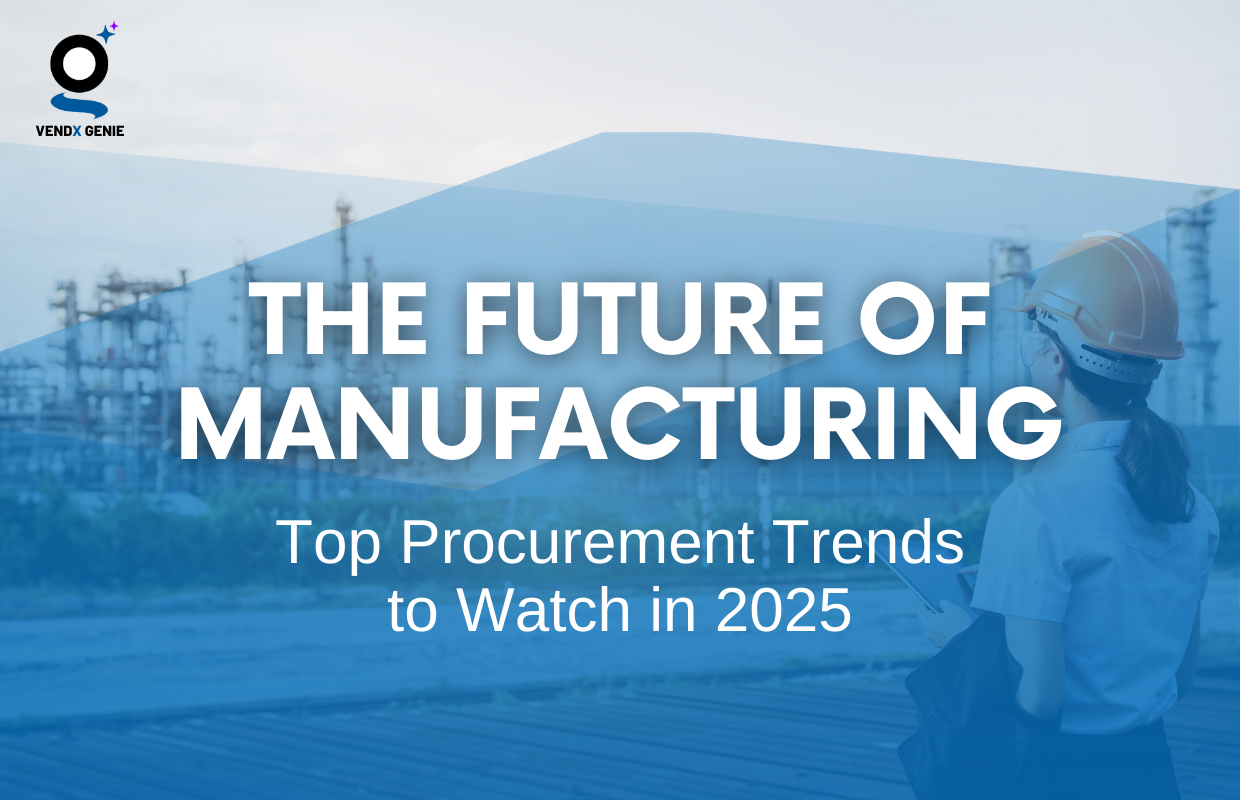
The Future of Manufacturing: Top Procurement Trends to Watch in 2025
Procurement in the manufacturing industry is undergoing a transformative shift, driven by technology advancements, economic uncertainties, and sustainability imperatives. As we approach 2025, manufacturing businesses must keep an eye on emerging procurement trends to maintain competitiveness and efficiency. Here are the key trends shaping the future of procurement in manufacturing:
Key Trends Shaping the Future of Procurement in Manufacturing
AI and ML for Smarter Procurement in Manufacturing
AI and machine learning are revolutionizing procurement processes in manufacturing. Predictive analytics enable manufacturers to forecast demand accurately, optimize inventory, and identify cost-saving opportunities. For instance, AI can analyze historical purchase data and market trends to recommend the best time to procure raw materials, reducing both costs and lead times.
Machine learning algorithms also enhance supplier evaluation by analyzing performance metrics such as delivery timelines and defect rates. This data-driven approach allows manufacturers to prioritize reliable suppliers and mitigate risks associated with poor-quality inputs.
Sustainability and Circular Procurement in Manufacturing
Sustainability is now a critical focus for manufacturers. Procurement teams are increasingly sourcing eco-friendly materials and partnering with suppliers who adopt sustainable practices. Circular procurement, emphasizing reuse and recycling, is gaining traction in industries like automotive and electronics.
For example, manufacturers are adopting closed-loop supply chains, where end-of-life products are collected, disassembled, and reintegrated into production. This reduces waste, lowers costs, and aligns with regulatory and consumer demands for sustainability.
Digital Twin Technology for Supply Chain Optimization
Digital twins—virtual replicas of physical assets—are becoming essential in manufacturing. By simulating procurement scenarios, manufacturers can identify potential bottlenecks and inefficiencies.
For instance, a digital twin can evaluate the impact of sourcing a critical component from a new supplier, helping businesses make informed decisions and proactively address disruptions like delays or shortages.
Blockchain for Transparency and Traceability
Traceability is critical in industries such as food processing, pharmaceuticals, and electronics. Blockchain technology ensures transparency by providing a tamper-proof ledger of procurement transactions.
Manufacturers can track the origin of raw materials, verify certifications, and ensure compliance with regulatory standards. For example, an electronics manufacturer can use blockchain to confirm that rare earth metals are sourced ethically, addressing both regulatory and consumer expectations.
Resilience Through Supplier Diversification
The pandemic highlighted the risks of over-reliance on single suppliers or regions. Manufacturers are now diversifying their supplier base to build resilience. Nearshoring and regional sourcing strategies are reducing dependency on distant suppliers and mitigating risks like geopolitical tensions or shipping delays.
For instance, automotive manufacturers are increasingly sourcing components regionally to ensure continuity and reduce lead times.
Cloud-Based Procurement Platforms
Cloud technology is transforming procurement in manufacturing by enabling real-time collaboration with suppliers. These cloud procurement platforms centralize purchase orders, contracts, and supplier data, providing greater visibility and control.
Manufacturers are using these platforms to automate repetitive tasks, such as purchase order generation, freeing up teams to focus on strategic initiatives. Real-time data sharing also enhances coordination, leading to faster issue resolution.
Advanced Supplier Relationship Management (SRM)
In 2025, supplier relationship management will be critical for manufacturing. AI-powered SRM tools allow real-time monitoring of supplier performance metrics like quality, delivery, and cost efficiency.
Strong supplier relationships are particularly vital in industries like aerospace and electronics, where specialized components and long lead times demand close collaboration. Advanced SRM tools foster innovation and long-term value by enabling manufacturers to co-develop solutions with suppliers.
Conclusion
The future of procurement in manufacturing is defined by technology, sustainability, and resilience. By adopting these trends, manufacturers can optimize procurement strategies, reduce costs, and build robust supply chains. Staying ahead of these changes will be essential for success in an increasingly complex and competitive landscape.
Let’s Prepare for 2025 Together
Our team can help align your procurement strategy with the latest trends to ensure success in a dynamic manufacturing landscape. Contact us today to learn more.
For more insights like these, follow us on LinkedIn and subscribe to our newsletter for exclusive updates on procurement innovation.

